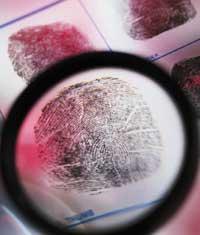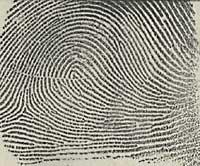Fingerprint identification
2002/02/10 Mendiburu, Joana - Elhuyar Zientziaren Komunikazioa

XX. From the beginning of the 20th century until very recently, in criminological investigations there was no statement or testimony that belies the information provided by the fingerprint. For the researchers there was nothing more pleasant than finding a fingerprint, which guaranteed the absence of legal errors.
But a Philadelphia judge has questioned the fingerprint. On January 7, the Jew Louis Polla handed down a ruling on the ‘United States vs Plaza’ case, on the clashes between two Puerto Rican mafias. According to him, scientifically it is impossible to say that two fingers are exactly the same.
It does not question that each individual's fingerprints are unique, but considers that expert comparisons cannot be entirely secure. Therefore, experts can only explain to the jury the similarities and differences and, in no case, indicate that the two fingerprints are equal.
Pollas Juje's statements have been taken very seriously by experts, although it is not the first time that identification with finger marks is questioned. In 1999, a lawyer first questioned identification through fingerprints in a trial. Twenty other attempts have been made since then but without success.
Judge Polla based his sentence on a 1993 jurisprudence. The Tribunal considers that scientific methods, to be considered, must meet the following requirements, be verified by scientific articles, be accepted by scientists in general and know the error rate.
According to Polla, fingerprint identification does not meet these requirements. According to expert David Stoney, researchers are based on a subjective perception that two finger marks are the same and not on standard and objective verification. In addition, according to Juje, although much has been written about fingerprints in the last century, not many fully scientific publications have been made.
History of fingerprints

Fingerprints are made of superficial hand and foot cretes. Chimpanzees, gorilla and orangutans also have fingerprints. In the embryo they form very early and retain unique characteristics throughout life. The fingerprints of each individual are unique (twins are also different), so they have been widely used in criminological research, medicine and archaeology.
But all this is not a thing of this morning. Footprints have been found in Palaeolithic caverns, although experts do not know why or why they were used. Since then, 5,000 years ago, transactions in Babylon consisted in depositing fingerprints on clay tablets, and later in ancient China.
In Europe, the Italian Marcello Malpighi was the 17th. The first to investigate fingerprints in the 19th century. Subsequently, in 1823, the Czech Jan Evangelista Purkinje classified fingerprints into nine groups, but in 1870 they were first used to identify people.
The idea focused on surgeon Henry Faulds of a Tokyo hospital when he identified fingerprints on a prehistoric ship. In 1880 he published in the journal Nature an article in which he published the idea and proposed using black ink to write fingerprints.
But Henry Fault's work did not stop. He discovered the possibility of using various types of dust to collect fingerprints and wrote to the well-known naturalist Charles Darwin to reveal his discoveries. By then Darwin had grown older and was not interested in the subject and forwarded the information to his cousin Francis Galton.

Galton approached the subject with great interest and spent ten years trying to classify the tracks. His goal, anthropologist, was to use fingerprints as characteristics of ethnic origin, but he realized that this was impossible. He showed that it is almost impossible to find two equal footprints
In 1891, Argentine police officer Juan Vucetich formed the first fingerprint file and was the first to identify a killer with fingerprints.
And until the judgment of January 7, handwriting was an unquestionable test. Now, several experts have pointed out the need to generate a debate on the certainty of the fingerprint and have recalled an old research that has so far been quite reserved. This study was conducted by the Collaborative Testing Service (CTS) in 1995 to analyze the work of 150 identifiers. The results were negative: 22% of the identifiers gave wrong identifications.
It seems that Polla's decision has raised powders and, perhaps, the rest of the clues used in police investigations (DNA, wheels, hairs...) must also be questioned. If you do jurisprudence, experts should discuss probabilities. That is, the probability that two DNA or two fingerprints are equal.
Published in 7K.

Gai honi buruzko eduki gehiago
Elhuyarrek garatutako teknologia




